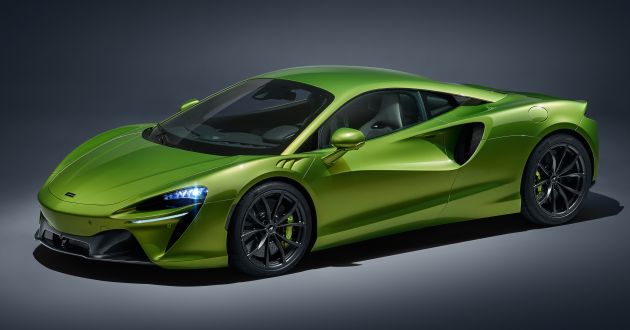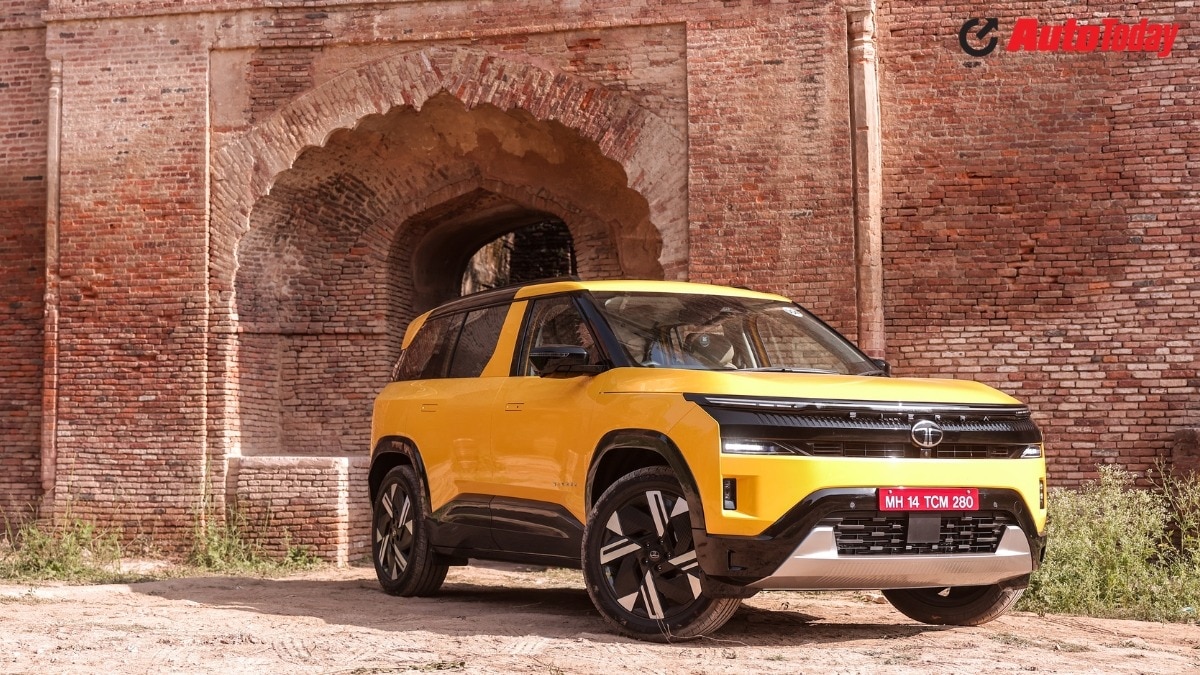McLaren Artura debuts – new plug-in hybrid supercar with 680 PS and 720 Nm; 0-100 km/h in three seconds
This is the McLaren Artura, and it represents the start of a new era for the Woking-based carmaker by being the company’s first series-production High-Performance Hybrid (HPH) supercar. Hybrid technology is something that McLaren has dabbled in before, but unlike the P1 that came before, the Artura won’t be limited in terms of production.
Like the P1, the Artura sports a plug-in hybrid powertrain, which is made up of a newly developed 3.0 litre twin-turbocharged V6 petrol engine. Capable of generating 585 PS (577 hp) at 7,500 rpm and 585 Nm of torque from 2,250 to 7,000 rpm, the M630 unit weighs just 160 kg, making it 50 kg lighter than a McLaren V8.
Other standout features include a dry sump lubrication system, a bore of 84 mm, a stroke of 90 mm, direct fuel injection operating at a pressure of 350 bar, a redline of 8,500 rpm and a 120-degree V-angle, with the last bit allowing the mono-scroll turbos to be positioned within the “hot vee.”
To add further potency, the Artura is the first McLaren to get an axial flux electric motor that weighs just 15.4 kg )including its own transmission interface), or less than half the weight of the 38 kg radial flux unit in the P1. The e-motor, which is mounted inside the bell housing of the car’s eight-speed dual-clutch transmission, provides 95 PS (94 hp) and 225 Nm, and it alone can get the car up to 130 km/h.
Working with the internal combustion engine, the total system output is 680 PS (671 hp) and 720 Nm, allowing for a zero to 100 km/h time of around three seconds, a 0-200 km/h time of 8.3 seconds, while top speed is limited to 330 km/h.
Power for the e-motor comes from a 7.4-kWh battery pack with five lithium-ion modules, which provides up to 30 km of electric-only range. This is packaged together with a power distribution unit to save space and is mounted on the rear section of the monocoque below the fuel tank, with aluminium inserts and a foam core for protection.
Cooling rails help channel refrigerant to indirectly cool the battery, while a DC/DC converter changes the high-voltage DC current to 12-volt power to run certain systems. An AC/DC converter meanwhile, handles charging current, with a 0-80% state of charge taking around 2.5 hours via a Type 2 connection.
Another first is the eight-speed dual-clutch transmission, which is 40 mm shorter in length despite having an extra gear over the seven-speed unit on McLaren’s V8-powered cars. This is achieved by using a nested clutch rather than a parallel clutch, and the company says you’ll enjoy fast gearshifts. The e-motor also plays a role here, smoothening the transition between ratios, particularly a lower vehicle and engine speeds.
Joining this combination is an electronically controlled differential (E-diff) to manage torque distribution across the rear axle. Aside from being smaller and lighter than a mechanical locking differential, the E-diff is more up to task when it comes to dealing with the immediate response and power delivery of the e-motor. McLaren’s Variable Drift Control (VDC) is also present, allowing drivers to adjust the level of traction control assistance via the infotainment system.
The entire drive system is paired with the McLaren Carbon Lightweight Architecture (MCLA), with the Artura being the first to use the platform. The MCLA is made up of a carbon monocoque occupant structure, a new chassis with aluminium subframes and a domain-based ethernet electrical architecture.
The last item reduces the length of cabling by 25% and runs many of the car’s systems, including the new McLaren Infotainment System (MIS II), electronic HVAC (eHVAC) system, hybrid system and for the first time in a McLaren, the Advanced Driver Assistance Systems (ADAS) suite (more on that later).
As for the scalable platform, it took four years to develop at the McLaren Composites Technology Centre in Sheffield, United Kingdom, and while it may resemble other carbon-fibre structures the company has revealed before, the MCLA must do more. To be specific, it not only needs to provide a high level of torsional rigidity, but also provide a safety cell for passengers, and just as important, for the car’s battery pack.
The monocoque alone weighs just 82 kg, and that includes the battery compartment, aero surfaces, B-pillars and door-hinge fixings. A low starting weight is important, especially when the plug-in hybrid components of the Artura tips the scales at 130 kg. According to official figures, the Artura has a kerb weight of 1,498 kg, or 1,395 dry.
Changes that aren’t immediately obvious at first glance are the four new carbon materials used in the monocoque’s construction, along with a new resin system and structural core material. McLaren also says the geometry of every surface is new, with taller A- and B-pillars compared to previous monocoques. The sides of the MCLA monocoque are also extended further back beyond the rear bulkhead to create the battery and fuel tank safety cell.
The suspension setup at the front features a front upper wishbone bolted directly to the monocoque, while the lower wishbone is attached to the subframe. Things get a little more complicated on the other end, where the upper link is a wishbone, but a multi-link setup is used for the lower portion. This is said to save 2.4 kg of unsprung mass on each side of the rear suspension, benefitting both ride and grip levels.
Twin-valve hydraulic dampers and McLaren’s second-generation Proactive Damping Control II system (Comfort, Sport and Track modes) are also standard, with the latter relying on inputs from sensors to “read” the road ahead rather than reacting to camera-based information. A series of sensors also supply information to the system, with fast processing (less than two milliseconds) to ensure a high level of control.
To slow things down, the braking system are carbon ceramic discs, with the former measuring 390 mm at the front and 380 mm at the rear. These are paired with six-piston monobloc front and four-piston rear calipers made from aluminium, with F1-style integrated cooling ducts inspired by those on the 765LT. The company notes that there is no regenerative braking needed because the engine can provide sufficient charging, and drivers will get a more consistent feel through the brake pedal.
A staggered wheel setup of 19-inch front and 20-inch cast alloy units are standard, but there’s an option for flow-formed or forged alloys, the latter trimming unsprung weight by 10 kg. Bespoke Pirelli P Zero tyres (marked MC-C) come in 235/35 front and 295/35 size, with more aggressive P-Zero Corsa and climate-focused P Zero Winter options also available.
Tyre conditions are measurable via wheel rim sensors, Pirelli Cyber Tyre monitoring system (with chips built into the tyre), so drivers are well-fed with information on setting up their car. In Track mode, tyre pressure thresholds can be changed on the infotainment display to a performance configuration to further enhance circuit driving enjoyment.
In terms of design, the Artura looks like a hybrid of the brand’s entry-level (and now defunct) Sport Series and higher-performance Super Series cars. Featuring a cab-forward layout, the car showcases a long and low nose, a long roofline, a steeply raked windscreen, an integrated rear spoiler, a full-width diffuser, as well as high fenders and haunches.


At the front, the company’s signature hammerhead line splits the airflow down into the eHVAC system and over the bonnet, leading the eye to the deeply recessed, 21-LED adaptive headlamps. Side vents near the headlamps bring air to the radiators, while vented louvres on the front fenders reduce pressure in the wheel arches.
Along the sides, the company’s typical dihedral doors are shaped to funnel air to intakes that conceal discreet inlets leading to the intake manifolds and engine radiators, which are smaller, having less engine capacity to cool.
Moving further back, flying buttresses extend from the single-piece aluminum roof to end on a one-piece rear clamshell. It’s not just visually appealing but functional too, as the base of the buttresses have inlets to help keep the transmission cool.
That hole in the rear deck also serves a purpose, as it serves as an exit point for air that helps cool the “hot vee” of the engine. Further efforts to extract air from the engine bay are the laser-cut mesh patterns, while the twin exhausts located between slim taillights bring with them emissions and a full-bodied exhaust note, even with particulate filters attached.
Inside, it’s typical McLaren minimalism, with almost all functions nestled within a vertically mounted, 8-inch MIS II infotainment screen that has a telemetry app plus Android Auto and Apple CarPlay support. This is angled towards the driver and has a watch-like “crown” attached. Nothing much going on with the centre console either, as that’s where the engine start/stop button, gear selector buttons and hazard light button reside.
Placing the driver first and foremost, the digital instrument cluster is mounted to the steering column, so whatever adjustment you make, you’ll have perfect visibility. Switching between the powertrain and drive modes is done via rocker switches on either side of the instrument binnacle, while the steering wheel itself has zero controls to ensure it does just one job: steer the car.
Standard here are the Clubsport seats, which are developed from those found in the Senna, and can be specified with a harness bar and six-point harnesses if you frequent the track. If you’re fine with adding another 9.5 kg, there’s the optional Comfort seat that provides 10-way adjustability and heating functions.
As mentioned earlier, the Artura is the first McLaren to offer ADAS, and the list of systems include Intelligent Adaptive Cruise Control with stop and go function, Road-Sign Recognition, Lane-Departure Warning and High-Beam Assist.
Beyond the standard trim, the company will also offer three further levels – Performance, TechLux and Vision – which allows customers to trim the entire cabin in Nappa leather in lieu of the default Alcanatra. Of course, McLaren Special Operations (MSO) is on hand to deliver any form of customisation you can think of, provided the budget is able to keep up.
The list of options is extensive, with the Technology Pack introducing a Bowers & Wilkins audio system, the ADAS package, 360-degree Park Assist. Adding the Practicality Pack nets you a front axle lifter to clear bumps, eight parking sensors (four on each end), power-folding heated door mirrors and Homelink.
So, the Artura is certainly a proper, all-new McLaren, with the MCLA, 3.0 litre twin-turbo V6, eight-speed DCT with an E-diff, ADAS, axial flux electric motor making their first appearance on this car. What about the name then? Well, the company says that Artura is an amalgamation of art and future. Seems apt, don’t you think?























































The post McLaren Artura debuts – new plug-in hybrid supercar with 680 PS and 720 Nm; 0-100 km/h in three seconds appeared first on Paul Tan's Automotive News.
from Paul Tan's Automotive News
Read The Rest:paultan...








Post a Comment